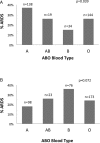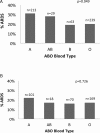ABO blood type A is associated with increased risk of ARDS in whites following both major trauma and severe sepsis
- PMID: 24385226
- PMCID: PMC3971970
- DOI: 10.1378/chest.13-1962
ABO blood type A is associated with increased risk of ARDS in whites following both major trauma and severe sepsis
Abstract
Background: ABO glycosyltransferases catalyze antigen modifications on various glycans and glycoproteins and determine the ABO blood types. Blood type A has been associated with increased risk of vascular diseases and differential circulating levels of proteins related to inflammation and endothelial function. The objective of this study was to determine the association of ABO blood types with ARDS risk in patients with major trauma and severe sepsis.
Methods: We conducted prospective cohort studies in two populations at an urban tertiary referral, level I trauma center. Critically ill patients (n 5 732) presenting after major trauma were followed for 5 days for ARDS development. Additionally, 976 medical patients with severe sepsis were followed for 5 days for ARDS. Multivariable logistic regression was used to adjust for confounders.
Results: ARDS developed in 197 of the 732 trauma patients (27%). Blood type A was associated with increased ARDS risk among whites (37% vs 24%; adjusted OR, 1.88; 95% CI, 1.14-3.12; P 5 .014), but not blacks (adjusted OR, 0.61; 95% CI, 0.33-1.13; P=.114). ARDS developed in 222 of the 976 patients with severe sepsis (23%). Blood type A was also associated with an increased ARDS risk among whites (31% vs 21%; adjusted OR, 1.67; 95% CI, 1.08-2.59; P=.021) but, again, not among blacks (adjusted OR, 1.17; 95% CI, 0.59-2.33; P=.652).
Conclusions: Blood type A is associated with an increased risk of ARDS in white patients with major trauma and severe sepsis. These results suggest a role for ABO glycans and glycosyltransferases in ARDS susceptibility.
Figures



Comment in
-
ABO blood type and ARDS.Chest. 2015 Feb;147(2):e67. doi: 10.1378/chest.14-2491. Chest. 2015. PMID: 25644927 No abstract available.
-
Response.Chest. 2015 Feb;147(2):e67-e68. doi: 10.1378/chest.14-2627. Chest. 2015. PMID: 25644928 No abstract available.
References
-
- Ware LB, Matthay MA. The acute respiratory distress syndrome. N Engl J Med. 2000;342(18):1334-1349 - PubMed
-
- Ware LB, Matthay MA. Alveolar fluid clearance is impaired in the majority of patients with acute lung injury and the acute respiratory distress syndrome. Am J Respir Crit Care Med. 2001;163(6):1376-1383 - PubMed
-
- Ware LB, Matthay MA, Parsons PE, Thompson BT, Januzzi JL, Eisner MD; National Heart, Lung, and Blood Institute Acute Respiratory Distress Syndrome Clinical Trials Network Pathogenetic and prognostic significance of altered coagulation and fibrinolysis in acute lung injury/acute respiratory distress syndrome. Crit Care Med. 2007;35(8):1821-1828 - PMC - PubMed
-
- Rubenfeld GD, Caldwell E, Peabody E, et al. Incidence and outcomes of acute lung injury. N Engl J Med. 2005;353(16):1685-1693 - PubMed
-
- Bernard GR, Artigas A, Brigham KL, et al. The American-European Consensus Conference on ARDS. Definitions, mechanisms, relevant outcomes, and clinical trial coordination. Am J Respir Crit Care Med. 1994;149(3):818-824 - PubMed
Publication types
MeSH terms
Substances
Grants and funding
- P01-HL079063/HL/NHLBI NIH HHS/United States
- P50-HL60290/HL/NHLBI NIH HHS/United States
- R01 HL081619/HL/NHLBI NIH HHS/United States
- K24 HL115354/HL/NHLBI NIH HHS/United States
- K23-DK097307/DK/NIDDK NIH HHS/United States
- K23 DK097307/DK/NIDDK NIH HHS/United States
- K24-HL115354/HL/NHLBI NIH HHS/United States
- U01 HL108636/HL/NHLBI NIH HHS/United States
- K12 HL109009/HL/NHLBI NIH HHS/United States
- K24 HL107643/HL/NHLBI NIH HHS/United States
- R01-HL081619/HL/NHLBI NIH HHS/United States
- T32-HL007891/HL/NHLBI NIH HHS/United States
- K23-HL102254/HL/NHLBI NIH HHS/United States
- K23 HL102254/HL/NHLBI NIH HHS/United States
- U01-HL108636/HL/NHLBI NIH HHS/United States
- P01 HL079063/HL/NHLBI NIH HHS/United States
- T32 HL007891/HL/NHLBI NIH HHS/United States
LinkOut - more resources
Full Text Sources
Other Literature Sources
Medical

